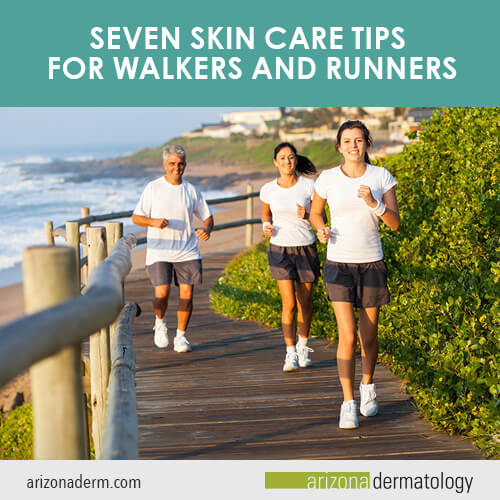 While much of the country is shivering and scraping windshields, here in Arizona we get to enjoy great weather in January. In fact, the cooler temperatures invite us to enjoy the outdoors by walking, hiking, and running. But just because the sun doesn’t feel strong doesn’t mean you don’t need to protect your skin. Here are seven tips to help you take care of your skin while you are enjoying Arizona’s great outdoors!
While much of the country is shivering and scraping windshields, here in Arizona we get to enjoy great weather in January. In fact, the cooler temperatures invite us to enjoy the outdoors by walking, hiking, and running. But just because the sun doesn’t feel strong doesn’t mean you don’t need to protect your skin. Here are seven tips to help you take care of your skin while you are enjoying Arizona’s great outdoors!
- Use a mineral sunscreen. There are two types of UV rays, UVA and UVB. UVB rays are the ones that tend to make you burn, but UVA rays penetrate more deeply and are responsible for premature aging and causing wrinkles. Chemical sunscreens (the most common options with ingredients like oxybenzone, avobenzone, and octinoxate) do a better job of blocking UVB rays than UVA rays. This means that if you use a chemical sunscreen, you may feel like you’re protecting yourself because you aren’t burning. But those insidious UVA rays are still affecting your skin. Mineral sunscreens, on the other hand, (those with ingredients like zinc oxide and titanium dioxide) protect well against both forms of UV light. As a runner, walker, or someone who plans to be outdoors for long periods, you are better off using mineral sunscreens on the exposed areas of your skin, such as your face, neck, chest and arms.
- Cover ears, lips, and the tip of the nose. Often overlooked, these areas are very vulnerable to the sun’s rays. Apply sunscreen liberally. For lips, look for a moisturizing lip balm that also contains a mineral sunscreen, like Elta MD broad-spectrum lip balm.
- Cover up with UPF clothing. UPF clothing is made of tightly woven material that minimizes the amount of sunlight that can penetrate it. Although they let very little sunlight in, they are still designed to be light, breathable, and to wick sweat away from the body. To be considered UPF clothing, an item must have an ultraviolet protection factor of over 15. (Standard clothing has a UPF factor of about 6.) A UPF factor of 15-20 is considered “good,” allowing only 4% to 6% of ambient UV radiation to penetrate the fabric. A rating of 25-35 is considered “very good,” allowing only 2.6% to 4% through. Factors of 40-50+ protect from all but about 2 to 2.5% of the sun’s UV rays. We give more info on UPF clothing in this blog post, which also talks about different UPF brands and where you can get them.
- Wear a hat. Wearing a hat with a wide brim will keep the sun off your face and help protect it from UV exposure. Sun hats work well for walkers and hikers. A ball cap may be better for runners. If the sun is hitting one side of your face, turn the brim so that it shades that area. Be careful because some hats made from straw or other loosely woven materials let in more light than you imagine. UPF clothing companies like Coolibar make UPF hats, too. Wearing a hat also protects the vulnerable skin of your scalp from UV exposure.
- Go early or late. The sun is strongest between the hours of 10AM and 4PM, so it’s best to schedule your outdoor time in the morning or evening.
- Get a yearly skin check. No matter what precautions you take, it’s always recommended to get an annual skin check with a dermatologist to make sure you don’t have skin cancers forming.
- Get dark spots treated. If you do notice dark spots or melasma starting, come see us. We have treatments like medications, chemical peels, or intense pulsed light therapies that can help.


